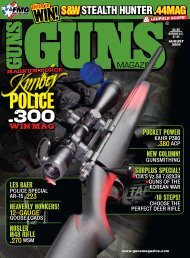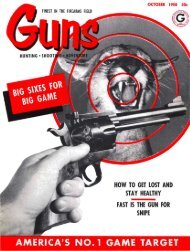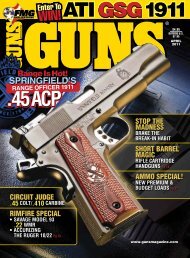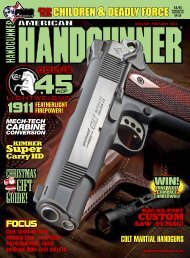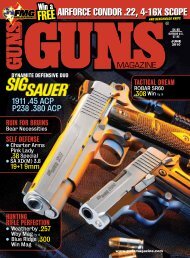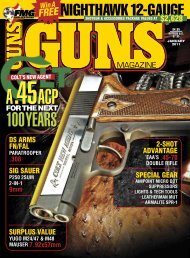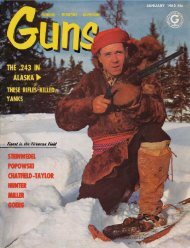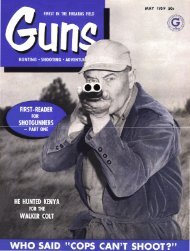GUNS Magazine December 1955 - Jeffersonian's Home Page
GUNS Magazine December 1955 - Jeffersonian's Home Page
GUNS Magazine December 1955 - Jeffersonian's Home Page
- No tags were found...
Create successful ePaper yourself
Turn your PDF publications into a flip-book with our unique Google optimized e-Paper software.
0Why pay out cold cash for guns you wantwhen you have money sitting in your gunrack? It doesn't make sense. 0Write us today what you have to trade andwe will do our best to work out a deal toyour satisfaction. Most all new guns are instock at regular prices and used ones tooAND all are available for trade. DescribeYour gun in full mentioning every alterationfrom the original, let us know what youwish in trade and we will Air Mail our offerto you. We allow fair dealer prices on everythingwe can use. We can't accept everygun but it's worth writing us for you can'ttall until you do.We especially need Colt National Match 45and 38 Super Match autos, good Lugerf,357 Magnums, Frontier Colts, BrowningSMM High Powers with sliding rear sight,Colt and Remington percussion pieces andother good antiques; National Match Springfields,issue 30-06 Springfield with goodumbers, other American and foreign m111-tary pieces; Browning Auto shotguns, w~nester7OVs, 50's, 32's. Remington 722's.721's, 760's, 740's or what have you?Write us now what you have to trade andget our offer by Air Mail. Fair Deal Allow.ance. Guaranteed Satisfaction. Prepatd andInsured Shipment. Courteous Prompt Service-that's the deal at Greenwood's. WriteMack GreenwoodGREENWOOD & COMPANYWASHINGTON 13, INDIANAWHOLESALE = RETAIL<strong>GUNS</strong> SCOPESReloading Tools BinocularsCameras <strong>Home</strong> Shop Tools<strong>Home</strong> Appliances OutboardMotors 0 Boats TentsSleeping Bags ArcheryFishing TackleFREE CATALOGRAY ROUSH, Box 66, Hoagland, Indiana-WorldFamous Featherweight Automatic--Order By Mail. Send Only $10. Pay BaZance on Delivery.Codfrey Import Corp., C-12, 277 Broadway, N.Y.C. 1NEW J. Dewey "THUMBSLIDE"TAN1 SAFETIES FOR ALL NEWCURVED RECEIVER REMINGTONSHOT<strong>GUNS</strong> & RIFLESMod. 760 Slide action rifles. Mod. 740 Auto rifles. Mod.870 Wingmaster Shotouns. Mod. I I 48 and new I I 48Sportsman auto Shotguns, New Rem. 22 cal. Model 572.Price comoletely installed at our plant is $17.00.WRITE FOR FOLDERJ. DEWEY GUN CO.East HamptonConnecticut'who then took a shot at the bird with hisflintlock before it disappeared into theroyal blue yonder.It was not till about 1825 that trapshootingjumped the Atlantic to our country. TheCincinnati Sportsmen's Club was our firsttrapshooting club organized here, establishedin 1831.In America as in England only live birdswere used for targets. Unfortunately, ournow extinct Passenger pigeon bore thebrunt of being the most popular target.Trapshooting in the "good ole' days" wasnot only tough on the birds but on theshooters as well. The rules of the sportcalled for the shooter to be 21 yards fromwhere the singles (one bird) were releasedas compared to 16 yards now, and 18 yardsfrom two birds (doubles). It's also only 16yards today. In those days the shooter hadto drop the bird within 100 yards of the firingline, and then retrieve the bird or birds byhand within three minutes.By 1866 trap shooting was increasing inpopularity and the Passenger pigeon wasrapidly being exterminated by the trapshooter,farmers, city slickers, and everyoneelse who owned a firearm. It was in thisyear that the glass ball filled with featherswas introduced for target work.Glass ball targets were launched from behinddirt ramparts by springboards. However,the glass ball "birds" weren't too satisfactorybecause of their poor trap delivery anderratic flight.Trapshooting made another step forwardin the 1880's, when a fellow by the nameof Ligowski invented a new trap and birdthat was vastly superior to the glass ballspringboardaffair. Ligowski's invention wasa target (bird) that had a flipper which engagedthe spring trap machine in such a wayso as to throw it (target) at different angles.New life came to trapshooting with theadvent of smokeless powder, chilled shot,choke-bore guns, and new traps and targets,and the sport took on a national importance.Many local and state organizations beganmaking their own rules and regulations,which created much confusion among theshooters from various locales. In 1892, theInterstate Trapshooting Association wasformed with the financial blessings of thegun and ammunition manufacturers whowere naturally interested in promoting thesport. By 1923 the association's name hadbeen changed to Amateur TrapshootersAssociation and was handed over to thenovice shooters with the ammo and gun companiesfading away.In trapshooting, pump-action and singlebarreled shotguns are the favorite, all ofthem being 12 gauge. In the pumps, mostshooters prefer 30 inch barrels and boredfull choke. In the single barrel one shotjobs, 32 inch barrels are preferred, bored fullchoke or improved-modified. The RemingtonM 870 Trap, Winchester Model 12, andIthaca Model 37T are all good pump trapguns. .The Ithaca simple-trap is an especial favoriteof expert shooters but costs upwards of$400 as it isn't made in plain grade.Automatic type shotguns aren't commonlyused on trap ranges because the ejected shellswill usually land, on or bother the man at thenext station to the shooter's right. However.here is a device on the market now that willieflect an ejected shell downward towardsthe shooter's feet instead, at the man at thenext station. Compensators and variablechoke devices aren't too popular on the traprange either as their muzzle blasts would beuncomfortable to other men in the squad.Trap shooting is good practice and doeskeep a shooter in trim, but it certainlydoesn't compare to actual shooting in thefield. To begin with, at traps the shooteras the rule is standing still, has his gun tohis shoulder, cocked and aimed, and knowsthat his target will, upon his commandspring up in front of him some 16 yards distant.Field shooting embodies greater surprise.Another argument against trapshootingvoiced by the hunting and gun experts is inthe speed of the targets. The clay targetwhen it leaves the trap is going at a considerablespeed and then slows down as itgets further away from the trap. Just theopposite is true in upland game hunting;for example a pheasant usually leaves coverflying rather slowly and picks up speed ashe goes.Ragardless of some of the "faults" oftrapshooting it does teach the shooter how toswing and time his shots.Skeet is an American game developedin this country in the early 1920's and isconsidered to be a better game to practicefor shooters who want to shoot their limit inthe field. Before World War I, skeet did notexist. It is said that the army "invented"skeet, developed it out of specialized combatshotgun training. After the war, skeetrapidly boomed to prominence as a contenderwith trap for the attention of the nation'sshotgunners.In a typical skeet layout there are twotrap houses, one for hurling the targets ata high angle, and the other house for throwingthe targets at a low angle. Targets fromeach of the two houses always follow thesame trajectory, but the shooters get differentangles by firing from the differentstations that are in a semi-circle between thetwo houses. The two trap houses are on aline with each other and are 40 yards apart.The skeeter starts at station #1 which isat the left of the field, the "high house,"and then proceeds around the semi-circleto his right to each station, with station #7at the "low house" where the traps areflung out fast from directly by his rightelbow. If a group is shooting, each memberof the two-to-five man team shoots atthe same station, and then the team moveson to the next station, unlike traps where thefive are strung out in a semi-circle, eachshooter at one station, and the shots fired inrotation.The #8 station in skeet is pretty rugged.It beats the doubles at #7 from high andlow houses, for at least on those two youhave some distance to swing through inorder to get either or both. In the No. 8you are on the spot midway between thetwo houses. The bird approaches directlyacross your front, and you cannot shoot itbeyond the midpoint. Any onlooker will seeplenty of birds shot by gunners whose backsare arched and guns pointed over their heads.Referees would score these as misses, sincethe bird by ruling cannot be followed beyondthe mid-point.Another important difference betweenskeet and trap is that skeet mixes in doubleswith singles in the same round. The shooter




